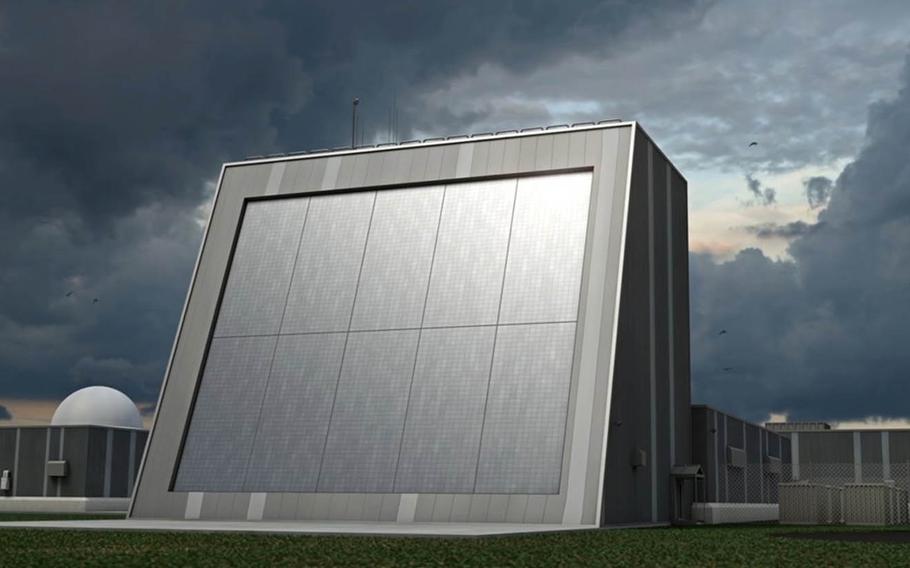
The Missile Defense Agency announced today that Kauai is the “preferred “ location in an ongoing environmental analysis for the $1.9 billion Homeland Defense Radar-Hawaii, shown here in an artist’s conceptual rendering. (Missile Defense Agency)
HONOLULU (Tribune News Service) —The Missile Defense Agency announced on Monday that Kauai is the "preferred" location in an ongoing environmental analysis for the $1.9 billion Homeland Defense Radar-Hawaii — an all-but-dead project in the eyes of the Pentagon as it contends with maneuvering hypersonic threats.
Hawaii's congressional delegation wants the project to proceed for the defense of the Aloha State against North Korean ballistic missiles.
Last year, Congress pumped $133 million back into the Hawaii project to keep it going after the Pentagon zeroed out funding for the radar.
The fiscal 2017 National Defense Authorization Act requires the Missile Defense Agency to develop a plan to construct and operate a "discrimination radar, " or equivalent sensor, that will improve homeland missile defense for Hawaii, according to the agency.
Agency spokeswoman Heather Cavaliere said the Pacific Missile Range Facility was identified as its preferred alternative. The Navy installation would provide "optimal " missile defense system performance and it "minimizes mission impacts to the host installation " she said.
The agency took into consideration "operational effectiveness, technical factors and environmental consideration " in selecting PMRF, Cavaliere said.
A Kahuku Training Area site on Oahu "will remain a reasonable alternative analyzed in the EIS, " she said. Identification of the Kauai alternative "provides ability for the MDA to better coordinate discussions and consultations with regulatory agencies."
Funding for the big Hawaii radar was again recently zeroed out in the U.S. Missile Defense Agency's 2022 proposed budget — a position that reflects evolving and competing defense priorities amid limited funding.
In 2019, the Hawaii radar was postponed, and in two subsequent budget years, no funding has been sought by the Pentagon.
U.S. Sen. Mazie Hirono, D- Hawaii, recently said the Department of Defense "previously identified the Homeland Defense Radar-Hawaii (HDR-H ) as the capability it needed to protect Hawaii in response to an increasingly credible North Korean ballistic missile threat."
"Last year when this happened, DOD did not satisfactorily explain why it cut funding for HDR-H in its proposed budget, prompting Congress to reverse the Trump Administration's request and fund the project at $133 million, " Hirono said in a statement. "Once again, DOD has also yet to adequately explain how Hawaii will be protected without HDR-H and whether our state will have the same level of protection as the rest of the United States."
The Pentagon previously noted a radar coverage "gap " in the Pacific.
Hirono said U.S. Indo-Pacific Command, the Missile Defense Agency and the incoming commander of U.S. Forces Korea "have all identified HDR-H as a priority for the protection of Hawaii."
"If DOD has new analysis and wants to propose a new system to achieve the same capability, I welcome the chance to hear about it, " the senator said. "However, in an increasingly unpredictable region, now is not the time to cut funding for missile detection technology without an assurance of enhanced protection from another source."
The Missile Defense Agency said the Hawaii radar, with an 85-foot face, would help track and discriminate (i.e., identify warheads among debris and decoys ) increasingly sophisticated long-range missile threats in the Pacific theater.
The agency said it is using the $133 million congressional "plus up " for production of "critical radar components " and studies "for the siting and development of the (radar )—should a deployment decision be made and is funded."
Being considered is a site at the southern end of PMRF on Kauai facing North Korea. Restricted airspace arcs would fan out over the ocean to a distance of 9 miles.
Testifying last year before a congressional committee, Missile Defense Agency Director Vice Adm. Jon Hill said the U.S. was at an "inflection point " that was complicating missile defense.
"Ballistic, hypersonic and cruise missiles are becoming more capable of carrying conventional and mass destruction payloads farther, faster and with greater accuracy, " he said in prepared remarks.
Missile defense will "continue to leverage space-based, ground-based and maneuverable sea-based sensors, " Hill said. "Yet there will never be enough terrestrial-based sensors to track maneuvering missiles in large numbers. If we are to outpace the threat, we need a persistent space-based global sensor capability."
The Missile Defense Agency and Space Development Agency are developing space-based systems to defend against Russian and Chinese hypersonic weapons.
Hypersonic and Ballistic Tracking Space Sensor, or HBTSS, satellites, are needed "since we cannot populate the earth and the oceans with terrestrial radars, " the agency said.
Hill recently noted that hypersonics are "a globally maneuvering kind of threat so you need to be up in space looking down." The space sensor program is on a path to launch two satellites built by two industry teams in the 2023 timeframe that would contribute to Pacific defense, Hill said.
"The 'birth to death' tracking that HBTSS can provide when integrated with terrestrial sensors will make it possible to maintain custody of missile threats from launch through intercept regardless of location, " the Missile Defense Agency said.
(c)2021 The Honolulu Star-Advertiser
Visit The Honolulu Star-Advertiser at www.staradvertiser.com
Distributed by Tribune Content Agency, LLC.